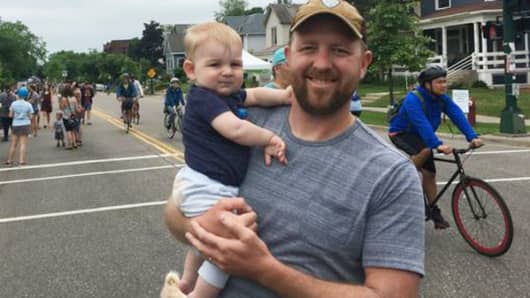Source: Michael Sonn
WASHINGTON (CNBC) – When Congress authorized a $350 million fund to help fix a popular but troubled student loan forgiveness program earlier this year, Michael Sonn was excited.
Finally, he thought, he might be debt-free.
However, the remedy isn’t going too well.
Nearly 34,000 people have applied for loan forgiveness through the fix-it fund, according to data shared this week at a conference held by the Department of Education.
Just 26 borrowers have been approved.
More than 20,000 applications are still pending because the borrower hasn’t yet been denied public service loan forgiveness, a requirement that has been criticized by consumer advocates as an unnecessary hurdle.
Sonn is one of the many public servants denied for the original program — and now denied again from the fund created to remedy the original program.
After more than a decade of student loan payments, Sonn had learned he didn’t qualify for public service loan forgiveness because he was enrolled in the wrong repayment plan. He’s far from alone — 99 percent of the original program’s applicants have been rejected, recent Education Department data show.
Public service loan forgiveness (PSLF) allows certain not-for-profit and government employees to have their federal student loans canceled after 10 years of on-time payments.
But most people, like Sonn, are rejected because they don’t fulfill one of the requirements. Advocates say that student loan servicers have failed to guide borrowers to the consumer protection.
It’s the responsibility of Education Secretary Betsy DeVos to implement Congress’ fund to fix some of the flaws of the public service loan forgiveness program, said Sen. Tim Kaine, D-Va, who has criticized the program’s flaws.
“I hope the Trump Administration will turn things around by creating a simple process that gives fair consideration to the teachers, military personnel, law enforcement officers, and other public servants who apply for this debt relief,” he said.
Liz Hill, press secretary at the U.S. Department of Education, said they implement programs Congress creates.
“[These] are poorly constructed programs, the rules of which are highly complex and difficult for students to navigate,” Hill wrote in an email. “We are working to make it as straightforward as the rules allow.”
These are the public service loan forgiveness requirements. Often, if you don’t meet one of them, you can make changes so that you do.
- Your must have federal direct loans.
- Your employer must be a government organization at any level, a 501(c)(3) not-for-profit organization or some other type of not-for-profit organization that provides public service.
- By the end, you need to have made 120 qualifying, on-time payments in an income-driven repayment plan or the standard repayment plan.
Congress’ fix to the program earlier this year addressed people who had been denied the loan forgiveness simply because they had been repaying their debt in a disqualifying plan. Those people were offered a second chance at having their debt canceled.
That’s why Sonn was hopeful, and quickly reapplied. However, he was told he still wasn’t eligible because he hasn’t made enough payments.
“That doesn’t make sense,” said Sonn, who works for the Minnesota Department of Transportation. “I’ve been paying for 12 years now.”
But then he learned that, even though he graduated in 2006 and has spent his entire career in public service, he had consolidated his loans in 2012 — and that reset the clock on his loan forgiveness. The soonest he will be eligible for loan forgiveness is in 2022.
By then, he said his student loan servicer told him, Congress’ fund will likely have run out.
“It feels like the hoops were put in place to not pay out in the end,” Sonn said.


